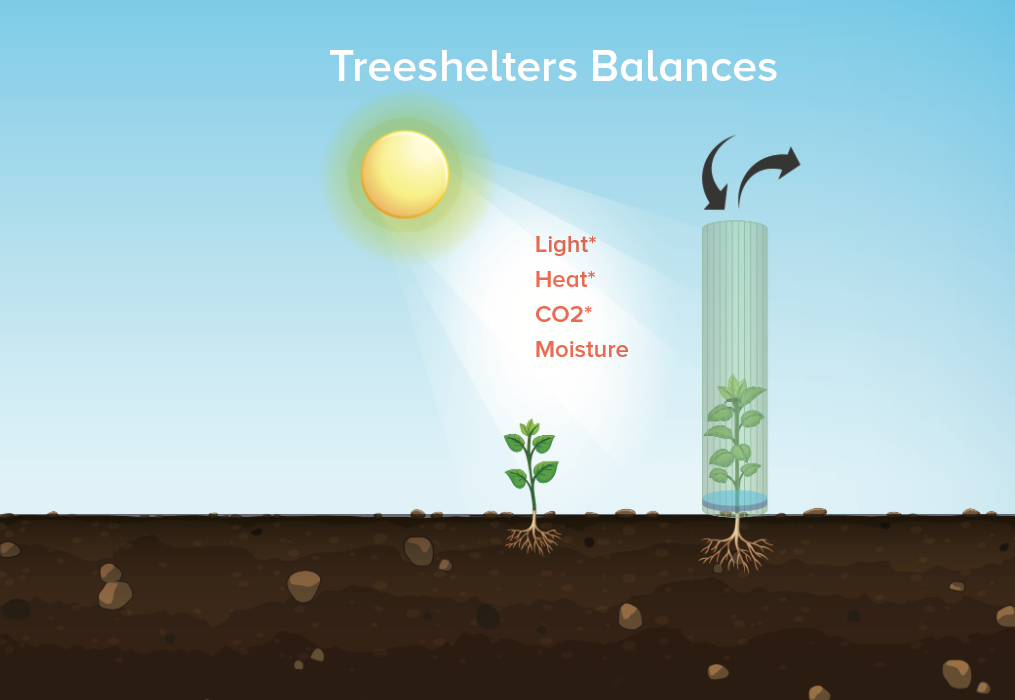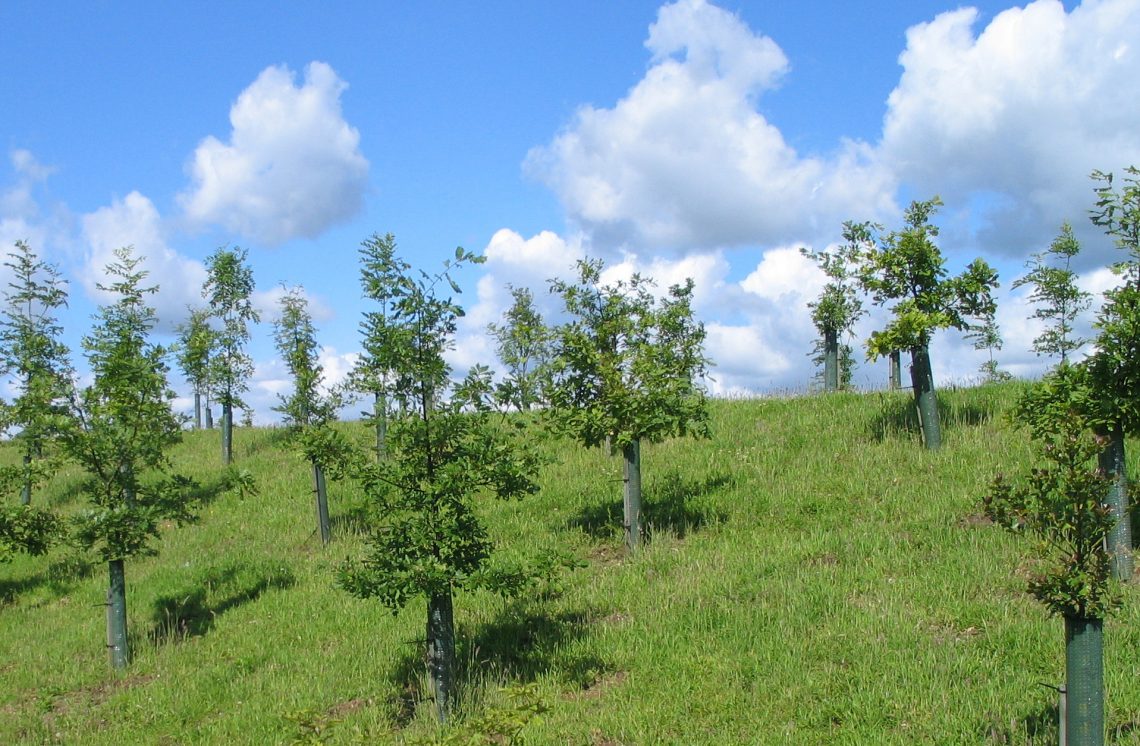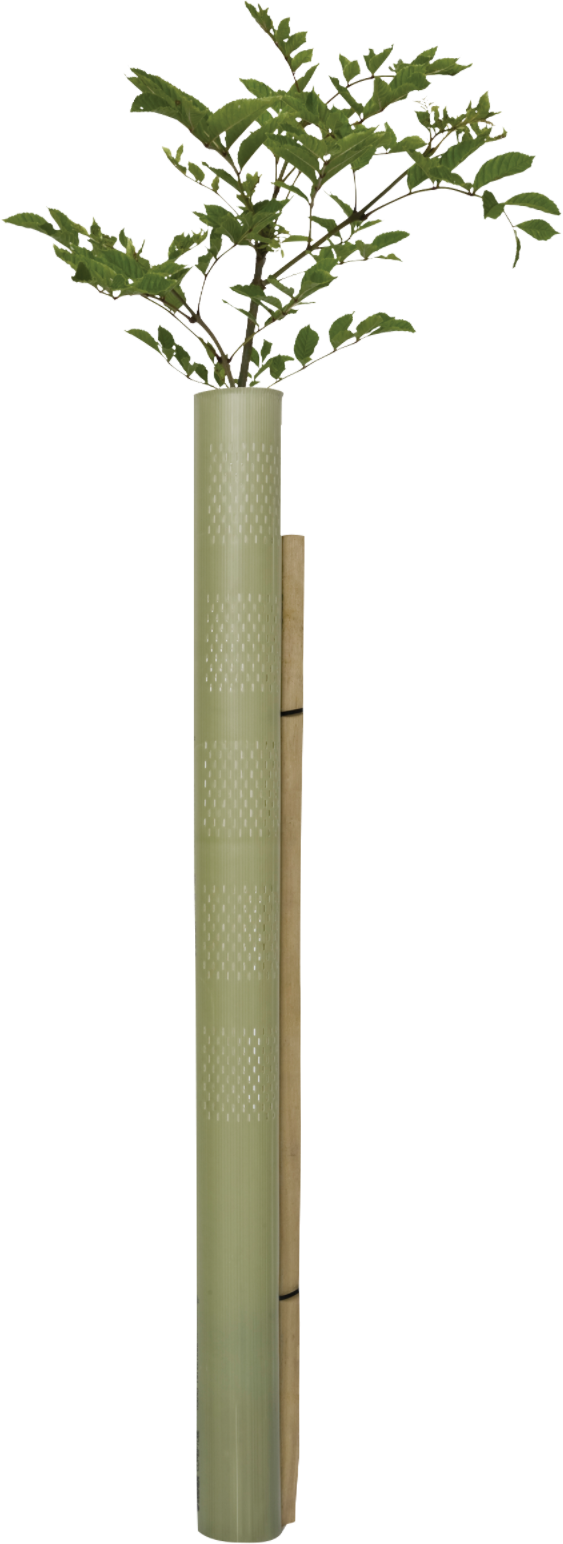
Benefits of Tree Shelters
Tree shelters enhance tree growth and development.
Why use a tree shelter?
Tree shelters enhance tree growth and development while providing individual protection from browsing animals. We estimated that in 2019 tree shelters saved 13 million saplings, which without individual tree protection would likely not have survived, this number is only for the UK market. The benefits of the tree shelters are explained below with the 3 main benefits
Tree shelters enhance growth
The tree shelter effect
The Forestry Commission in England did studies in the early 1980s to establish the effect of TUBEX tree shelters on various tree species. It was established that trees inside tree shelters have shown a significant increase in height compared to trees grown in nature, or inside mesh. The growth of a plant is significantly accelerated in a tree shelter compared to trees grown in tree nets or in nature.
This is because the tree shelter provides an ideal microclimate that is conducive to improved plant growth. The factors that contribute to the microclimate include temperature, levels of carbon dioxide and moisture, light spectrum and intensity.
Warmth, CO2, moisture and light spectrum and intensity are the factors that contribute to generate a microclimate and are as well the factors intervene in the key process of photosynthesis, respiration and photomorphogenesis.

Tree shelters create a different microclimate for the plant to grow
Within the treeshelter, a microclimate is generated that is somewhat different from the open environment. The factors that compose this microclimate are warmth, varying levels of moisture and CO2, reduced air movement, and reduced and modified light. All these factors have an impact on the growth of the tree and on its biomass distribution through the processes of photosynthesis, respiration, transpiration and photomorphogenesis. The microclimate has therefore an important impact on the metabolism or growth of the tree and affects the assimilation rate of carbon dioxide, the transpiration rate, the energy budget of the leaves, etc.
The various factors composing the microclimate can be measured and can be related to the tree’s well-being. Whereas heat can be measured by temperature, moisture in the air can be measured by relative humidity (% RH) or vapour pressure. In particular, the vapour pressure deficit (VPD), the difference between the amount of moisture in the air and how much moisture the air can hold when it is saturated, is very relevant for growth of seedlings. Indeed, as the VPD increases as the air dries, the plant needs to draw more water from its roots. Another measure is the Leaf-to-Air Vapour Pressure Deficit (LAVPD). These factors affect the transpiration rate as measured by the transpiration flux density.

An intricate balance
For a plant to grow and develop properly it must balance photosynthesis, respiration, and transpiration. Left to their own devices, plants do a good job of managing this intricate balance. If a plant photosynthesises at a high rate, but its respiration rate is not high enough to break down the photosynthates produced, photosynthesis will either slow down or stop. On the other hand, if respiration is much more rapid than photosynthesis, the plant will not have adequate photosynthates to produce energy for growth. Hence, growth either will slow down or stop altogether.
The transpiration rate of a tree depends on both climatic demand and its physiological capacity to meet this demand. Light radiation, the water vapour gradient between the leaf and its surrounding air, and the wind contribute to create the climatic demand. The development stage of the tree, the leaf surface, and the stomatal resistance modify the physiological capabilities of responding to the microclimatic demand.
Reduced transpiration rates may induce high leaf temperatures. This may be lethal for the foliage as temperatures inside the shelter may be 10oC higher than outside temperatures. On the other hand, such low transpiration rates may help conserve water reserves of the soil and delay the occurrence of a water deficit for the tree during the dry season. While this could be a useful attribute in dry areas, weeds and soil evaporation may use a significant amount of water saved by the tree. It is strongly recommended to weed around sheltered trees.
Continuous low transpiration may not be a problem as long as the shelter remains sealed. Indeed, a sudden air movement inside the shelter will induce very large transpiration rates, with no physiological control. In such circumstances, the tree may desiccate. It is therefore important that the tree shelter is well installed and the bottom in contact with the soil is sealed thus preventing a lifting by wind, animal or accident.

Impact
Sustainability at Tubex
0 M
Est SAPLINGS SAVED EACH YEAR, IN THE UK
0 Kg
MANUFACTURING A TREE SHELTER PRODUCES 0.44KG OF CO2
0 Kg
A TREE CAPTURES 2900 Kg of CO2 IN ITS LIFETIME
0 %
Tubex standard tree shelters contain up to 30% of recycled content
0 %
Tubex netting contains 85% of recycled content
+ 0 K
Tree shelters recycled through the Tubex Collection & Recycling programme in 2021

Effective
Protection